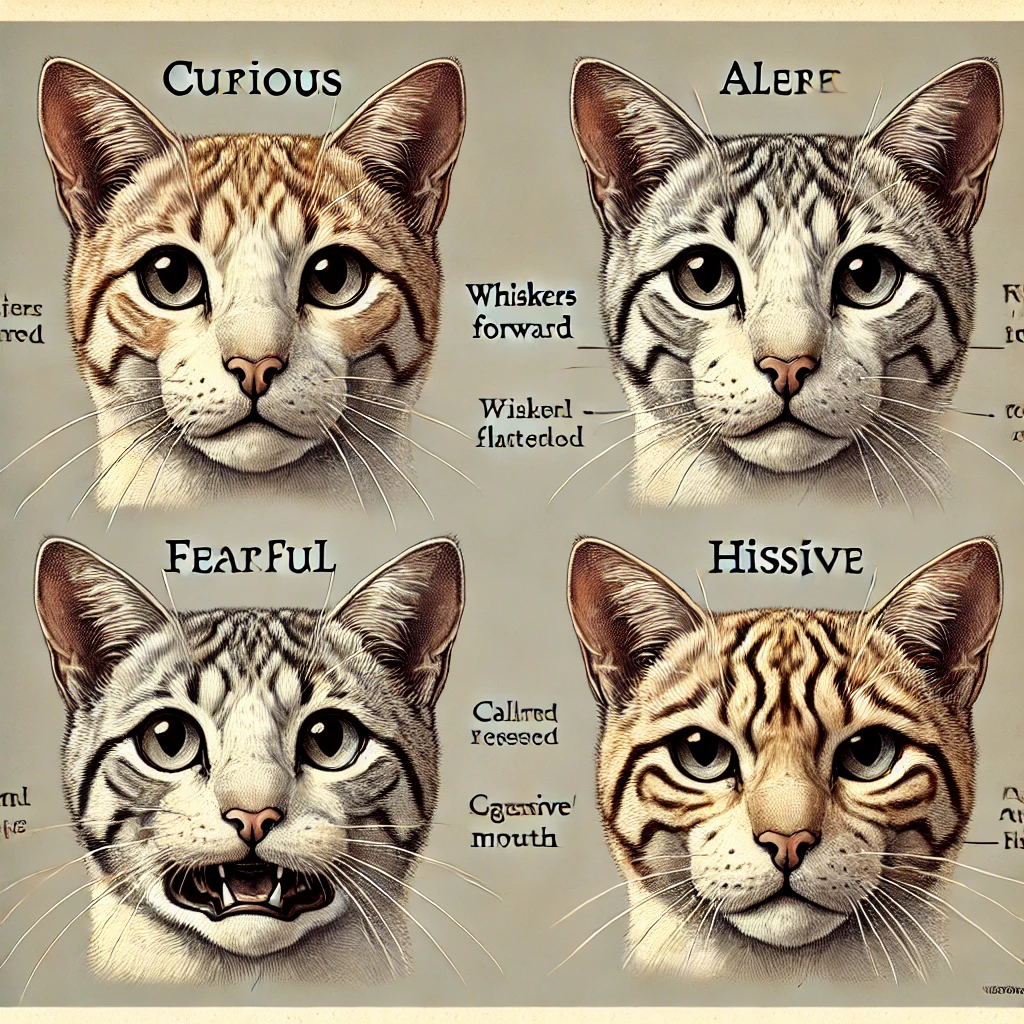Unlock the secrets of your cat’s emotions by understanding their facial expressions.
Introduction
Have you ever looked at your cat and wondered what they’re feeling? Cats may seem mysterious, but their faces can reveal a lot about their emotions. By learning to interpret subtle cat facial expressions, including whisker positions and mouth movements, you can better understand your feline friend and respond appropriately. In this article, we’ll explore the nuances of feline facial cues and how they combine with other body language to convey your cat’s feelings.
How Whisker Positions Indicate Interest or Discomfort
The Role of Whiskers in Cat Communication
Whiskers, or vibrissae, are not just cute features on your cat’s face; they are highly sensitive tools that help cats navigate their environment and express emotions.
Whiskers Forward
- Interest and Curiosity: When your cat’s whiskers are pushed forward, it often indicates that they are curious or interested in something.
- Focused Attention: This position is common when your cat is stalking a toy or observing something intriguing.
Whiskers Relaxed
- Contentment: Whiskers that are relaxed and resting naturally indicate that your cat is calm and comfortable.
- Neutral State: This is the default position when your cat is at ease.
Whiskers Pulled Back
- Anxiety or Fear: Whiskers flattened against the cheeks can signal that your cat is feeling anxious or scared.
- Defensive Posture: This position may accompany other signs of stress, such as flattened ears or dilated pupils.
Whiskers Flared Out
- Aggression or Agitation: Whiskers that are flared out to the sides may indicate that your cat is agitated or ready to defend themselves.
- Heightened Sensitivity: This can occur when your cat is overstimulated or irritated.
Learn more about interpreting your cat’s whisker positions
Mouth Movements: Yawning, Lip Licking, and the Flehmen Response
Yawning
- Relaxation: A yawn often signifies that your cat is relaxed and comfortable in their environment.
- Stress Release: Sometimes, yawning can be a way for your cat to release tension or stress.
- Contagious Yawning: Interestingly, cats may yawn in response to your own yawns, indicating a social bond.
Lip Licking
- Anxiety or Uncertainty: If your cat is licking their lips when there’s no food involved, it may indicate anxiety or discomfort.
- Anticipation: Lip licking can also occur when your cat is anticipating a meal or treat.
Flehmen Response
- Scent Analysis: When your cat lifts their head, curls back their upper lip, and opens their mouth slightly, they’re performing the Flehmen response.
- Gathering Information: This behavior allows them to draw scents into the vomeronasal organ (Jacobson’s organ) to analyze pheromones.
- Common Triggers: The Flehmen response is often seen when cats encounter strong or unusual smells, such as another cat’s scent.
Discover more about the Flehmen response
Combining Facial Cues with Other Body Language
Understanding cat facial expressions is most effective when combined with other body language signals.
Eyes
- Dilated Pupils: Can indicate excitement, fear, or aggression.
- Slow Blinking: A sign of trust and affection.
- Staring: May signify aggression or dominance.
Read about interpreting your cat’s eye language
Ears
- Ears Forward: Indicates interest or happiness.
- Ears Flattened: Suggests fear or aggression.
- Ears Swiveling: Shows alertness to sounds.
Learn to decode your cat’s ear positions
Tail
- Upright Tail: Signifies confidence and friendliness.
- Swishing Tail: Can indicate irritation or excitement.
- Puffed Tail: Shows fear or aggression.
Understand your cat’s tail movements
Body Posture
- Relaxed Posture: Your cat feels safe and comfortable.
- Tense Muscles: May indicate readiness to flee or fight.
- Crouching: Can signify fear or readiness to pounce.
Explore cat body language and postures
Practical Tips for Responding to Facial Expressions
Recognizing Contentment
- Relaxed Whiskers and Soft Eyes: Indicates your cat is happy. This is a good time for gentle interaction.
- Slow Blinking: Return the slow blink to show affection.
Identifying Stress or Discomfort
- Whiskers Pulled Back and Lip Licking: Your cat may be anxious. Give them space and a quiet environment.
- Flattened Ears and Dilated Pupils: Signs of fear or aggression. Avoid handling them until they’re calm.
Encouraging Positive Interactions
- Whiskers Forward and Ears Up: Your cat is curious and open to play or exploration.
- Provide Stimulating Toys: Engage them with interactive toys that satisfy their curiosity.
Find engaging toys for your cat
Conclusion
By paying attention to cat facial expressions, including whisker positions and mouth movements, you can gain valuable insights into your cat’s emotions and needs. Recognizing these subtle cues allows you to respond appropriately, strengthening your bond and ensuring your feline friend’s well-being. Remember, every cat is unique, so take the time to observe and learn your cat’s individual expressions. With patience and understanding, you’ll become fluent in your cat’s silent language, leading to a happier and more harmonious relationship.






